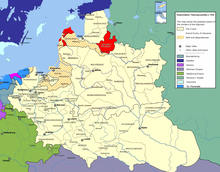The Anomebot2 (talk | contribs) Adding geodata: {{coord missing|Poland}} |
No edit summary |
||
| Line 76: | Line 76: | ||
[[it:Voivodato di Livonia]] |
[[it:Voivodato di Livonia]] |
||
[[lv:Inflantijas vaivadija]] |
|||
[[lt:Livonijos vaivadija]] |
[[lt:Livonijos vaivadija]] |
||
[[pl:Województwo inflanckie]] |
[[pl:Województwo inflanckie]] |
||
Revision as of 22:04, 30 September 2009
| Inflanty Voivodeship Livonian Voivodeship Województwo inflanckie | |||||||||
|---|---|---|---|---|---|---|---|---|---|
| Voivodeship of the Polish-Lithuanian Commonwealth | |||||||||
| 1621–1772 | |||||||||
 Inflanty in the Polish-Lithuanian Commonwealth, 1635. | |||||||||
| Capital | Dyneburg | ||||||||
| Area | |||||||||
• | 12,000 km2 (4,600 sq mi) | ||||||||
| History | |||||||||
| 1621 | |||||||||
• Treaty of Oliva | April 23, 1660 | ||||||||
| August 5 1772 | |||||||||
| |||||||||
The Inflanty Voivodeship (Polish: Województwo inflanckie) [1], or Livonian Voivodeship (Lithuanian: Livonijos vaivadija) also known as Polish Livonia was an administrative division and local government in the Polish-Lithuanian Commonwealth, since it was formed in the 1620s out of the Wenden Voivodeship and lasted until the First Partition of Poland in 1772. The Inflanty Voivodeship was one of the few territories of the Polish-Lithuanian Commonwealth to be ruled jointly by Poland and Lithuania.
The Inflanty Voivodeship, sometimes referred to the Principality of Inflanty after 1660 [citation needed], was the minority remainder of the Duchy of Livonia, which had been conquered by the Swedish Empire during the Polish–Swedish War of 1621–1625.
The seat of the voivode was Dyneburg (Daugavpils).
The name Inflanty is derived through Polonisation of Livland, the German name for Livonia. In modern times the region is known as Latgale in the Republic of Latvia.[2]
Voivodes
This is a list of the voivodes for Inflanty:
- Jerzy Farensbach
- Maciej Demblński
- Krzysztof Słuszka
- Teodor Doenhoff
- Joachim Tarnowski
- Tomasz Sapieha
- Paweł Sapieha
- Mikołaj Korft
- Przecław Leszczyński
- Alexander Morszlyn
- Jan Teodor
- Jerzy Płatem
- Otto Fryderyk Felkierzamb
- Jan Koss
- Jędrzej Głębocki
- Piotr Przebendowski
- Antozi Morsztyn
- Wilhelm Płatem
- Jan Borch
- Stanisław Brzostowski
- Jozafat (Jan) Zyberg
- Gaspar Rogaliński
- Adam Falkierzamb
References
- ^ Niesiecki, Kasper (1846). Herbarz polski Kaspra Niesieckiego (in Polish). Waif. p. 227.
{{cite book}}: Cite has empty unknown parameter:|coauthors=(help)CS1 maint: unrecognized language (link) - ^ Culture and Customs of the Baltic States By Kevin O'Connor; p. 14 ISBN 9780313331251

